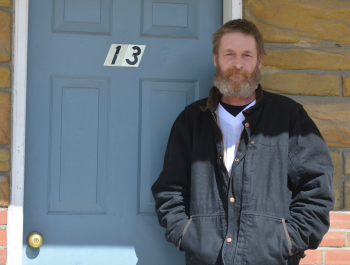Image

Chris Donnelly, Director of Community Relations, Champlain Housing Trust
Challenge: Homelessness rose by 60 percent in Vermont between 2008 and 2015, the nation’s third highest increase. After several homeless people died in the cold, the state introduced emergency vouchers for motel rooms. Meanwhile, Vermont’s hospitals had dozens of patients they could not discharge for lack of a safe landing spot.
Between 2008 and 2015, the number of homelessness in Vermont rose by 60 percent, the third highest increase in the nation. The state provided emergency vouchers for motel rooms after several homeless people died in the cold, and spending doubled to over $4 million. Meanwhile, Vermont’s hospitals had dozens of patients they could not discharge for lack of a safe landing spot. The costs of caring for preventable health needs of homeless people grew.
The Champlain Housing Trust (CHT), founded in 1984, serves communities in three counties in northwest Vermont. CHT manages 2,200 affordable apartments, stewards 575 owner-occupied homes in a shared-equity program and provides homebuyer education, financial fitness counseling, services to six housing cooperatives and affordable energy efficiency and rehab loans. In 2012, in the midst of significant increases in homelessness in Vermont, CHT decided to increase support for this most vulnerable population.
When fraud and abuse were discovered in the motel voucher program, lawmakers determined it was ineffective and inefficient. Our organization proposed a nonprofit motel with onsite social services.
Financing for the 59-room Harbor Place motel was primarily provided by the Vermont Community Loan Fund, a Community Development Financial Institution. The state’s Department of Children and Families (DCF), the administrator of the motel voucher program, contracted 30 of the 59 rooms for approximately half the cost the state paid for private motels. Other financing included a $200,000 reserve fund with contributions from DCF, the University of Vermont Medical Center and our local United Way chapter, as well as a grant from the Vermont Housing and Conservation Board of $265,000. Harbor Place produced about $700,000 worth of savings on the reduced room rate alone in the first two years and has served approximately 650 households per year. The motel has been consistently full in every season.
Case management services are provided onsite by a community action program, a health center and a domestic violence agency. Other partners provide mental health and addiction services and support new parents. The Medical Center committed to using our rooms for homeless patients who were ready for discharge.
 Having case management service on site means guests are five times more likely to be engaged with their managers, according to the agencies that serve them. Case managers report that people with easier access to these services at Harbor Place were also five times as likely to find permanent housing as those scattered at private motels. The Medical Center’s evaluation of 95 people renting rooms at Harbor Place after hospital discharge found that the number of encounters with hospital services was reduced by 42 percent and saved nearly $1 million in health costs.
Having case management service on site means guests are five times more likely to be engaged with their managers, according to the agencies that serve them. Case managers report that people with easier access to these services at Harbor Place were also five times as likely to find permanent housing as those scattered at private motels. The Medical Center’s evaluation of 95 people renting rooms at Harbor Place after hospital discharge found that the number of encounters with hospital services was reduced by 42 percent and saved nearly $1 million in health costs.Our collaboration at Harbor Place with the Community Health Center of Burlington’s Safe Harbor Homeless Health Care Program and the Medical Center led to an initiative to house 63 chronically homeless and medically vulnerable adults. Some were housed in our existing rental portfolio, but low vacancy rates limited our ability to help more of them.
CHT found a small hotel to convert to 19 efficiency and one-bedroom apartments, which cost approximately $100,000 per unit -- less than half the typical cost for new construction. The State’s Housing and Conservation Board provided a $500,000 grant for redevelopment. Safe Harbor supplied a full-time case manager with $100,000 funded by the Medical Center and the local housing authority provided non-elderly disabled and Shelter Plus Care portable vouchers for tenants that offered flexibility after one year.
“I felt like I was going to freeze to death in my car, but now I am alive and have a home of my own,” says Robert, who stayed at Harbor Place. “Last winter I was in the hospital ER many times, but no trips this winter.”
Neighbors near the apartments donated kitchen utensils and other household goods, and CHT staff have put in a community garden for the residents. Staff members are securing health information waivers from residents to document health system changes to identify savings on Medicaid expenses and unreimbursed health costs. CHT and the UVM Medical Center are collaborating on a public education campaign on the connection between health and housing, and the Medical Center committed a $3 million investment into additional health-related housing and community development initiatives led by CHT.
Through these two initiatives we learned the importance of leveraging the financial resources and services available through public and private organizations and to find the synergies between CHT’s mission and the goals of other organizations to house and support the most vulnerable members of our communities.

